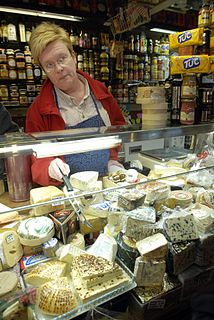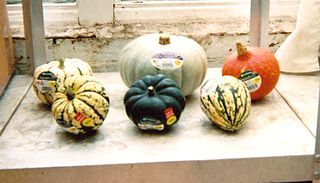
Loyalty programs are structured marketing strategies designed by merchants to encourage customers to continue to shop at or use the services of businesses associated with each program. These programs exist covering most types of commerce, each one having varying features and rewards-schemes.

A convenience store, convenience shop, or corner store is a small retail business that stocks a range of everyday items such as coffee, groceries, snack foods, confectionery, soft drinks, tobacco products, over-the-counter drugs, toiletries, newspapers, and magazines. In some jurisdictions, convenience stores are licensed to sell alcohol, although many such jurisdictions limit such beverages to those with relatively low alcoholic content such as beer and wine. Such stores may also offer money order and wire transfer services, along with the use of a fax machine or photocopier for a small per-copy cost. They differ from general stores and village shops in that they are not in a rural location and are used as a convenient supplement to larger stores.

A supermarket is a self-service shop offering a wide variety of food, beverages and household products, organized into sections and shelves. It is larger and has a wider selection than earlier grocery stores, but is smaller and more limited in the range of merchandise than a hypermarket or big-box market.

Shopping is an activity in which a customer browses the available goods or services presented by one or more retailers with the potential intent to purchase a suitable selection of them. A typology of shopper types has been developed by scholars which identifies one group of shoppers as recreational shoppers, that is, those who enjoy shopping and view it as a leisure activity.

Retail is the process of selling consumer goods or services to customers through multiple channels of distribution to earn a profit. Retailers satisfy demand identified through a supply chain. The term "retailer" is typically applied where a service provider fills the small orders of a large number of individuals, who are end-users, rather than large orders of a small number of wholesale, corporate or government clientele. Shopping generally refers to the act of buying products. Sometimes this is done to obtain final goods, including necessities such as food and clothing; sometimes it takes place as a recreational activity. Recreational shopping often involves window shopping and browsing: it does not always result in a purchase.
The theory of consumer choice is the branch of microeconomics that relates preferences to consumption expenditures and to consumer demand curves. It analyzes how consumers maximize the desirability of their consumption as measured by their preferences subject to limitations on their expenditures, by maximizing utility subject to a consumer budget constraint.

Consumer behaviour is the study of individuals, groups, or organizations and all the activities associated with the purchase, use and disposal of goods and services, including the consumer's emotional, mental and behavioural responses that precede or follow these activities. Consumer behaviour emerged in the 1940s and 50s as a distinct sub-discipline in the marketing area.
A discount store or discount shop is a retail shop which sells products at prices that are lower than the typical market price.
Online shopping is a form of electronic commerce which allows consumers to directly buy goods or services from a seller over the Internet using a web browser. Consumers find a product of interest by visiting the website of the retailer directly or by searching among alternative vendors using a shopping search engine, which displays the same product's availability and pricing at different e-retailers. As of 2016, customers can shop online using a range of different computers and devices, including desktop computers, laptops, tablet computers and smartphones.

Zayre was a chain of discount stores that operated in the eastern half of the United States from 1956 to 1990. The company's headquarters was in Framingham, Massachusetts. In October 1988, Zayre's parent company, Zayre Corp., sold the stores to the competing Ames Department Stores, Inc. chain, and in June 1989, Zayre Corp. merged with one of its subsidiaries, The TJX Companies, parent company of T.J. Maxx. A number of stores retained the Zayre name until 1990, by which time all stores were either closed or converted into Ames stores.

A consumer good or final good is any commodity that is produced or consumed by the consumer to satisfy current wants or needs. Consumer goods are ultimately consumed, rather than used in the production of another good. For example, a microwave oven or a bicycle that is sold to a consumer is a final good or consumer good, but the components that are sold to be used in those goods are intermediate goods. For example, textiles or transistors can be used to make some further goods.

Kesko Corporation is a Finnish retailing conglomerate with its head office in Ruskeasuo, Helsinki. It is engaged in the food trade, the home and specialty goods trade, the building and home improvement trade, and the car and machinery trade. It also has subsidiaries in Sweden, Norway, Estonia, Latvia, Lithuania, Russia, and Belarus.

Planograms, also known as plano-grams, plan-o-grams, schematics and POGs, are visual representations of a store's products or services on display. They are considered a tool for visual merchandising. According to the Oxford English Dictionary, a planogram "is a diagram or model that indicates the placement of retail products on shelves in order to maximize sales." The effectiveness of the planogram can be measured by the sales volume generated from the specific area being diagramed.

Visual merchandising is the practice in the retail industry of developing floor plans and three-dimensional displays in order to maximize sales.

A stockout, or out-of-stock (OOS) event is an event that causes inventory to be exhausted. While out-of-stocks can occur along the entire supply chain, the most visible kind are retail out-of-stocks in the fast-moving consumer goods industry. Stockouts are the opposite of overstocks, where too much inventory is retained.

Food marketing brings together the food producer and the consumer through a chain of marketing activities.
A marketing channel is the people, organizations, and activities necessary to transfer the ownership of goods from the point of production to the point of consumption. It is the way products get to the end-user, the consumer; and is also known as a distribution channel. A marketing channel is a useful tool for management, and is crucial to creating an effective and well-planned marketing strategy.
Shopper marketing is "understanding how one's target consumers behave as shoppers, in different channels and formats, and leveraging this intelligence to the benefit of all stakeholders, defined as brands, consumers, retailers and shoppers." According to Chris Hoyt, "Shopper marketing [is] brand marketing in retail environment." Since it includes category management, displays, sales, packaging, promotion, research and marketing "Shopper marketing is the elephant in the room that nobody sees the same way."
Fashion merchandising can be defined as the planning and promotion of sales by presenting a product to the right market at the proper time, by carrying out organized, skillful advertising, using attractive displays, etc. Merchandising, within fashion retail, refers specifically to the stock planning, management, and control process. Fashion Merchandising is a job that is done world- wide. This position requires well-developed quantitative skills, and natural ability to discover trends, meaning relationships and interrelationships among standard sales and stock figures.[1]In the fashion industry, there are two different merchandising teams: the visual merchandising team, and the fashion merchandising team.













